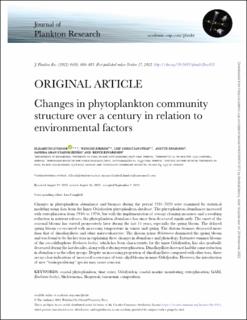| dc.contributor.author | Lundsør, Elisabeth | |
| dc.contributor.author | Eikrem, Wenche | |
| dc.contributor.author | Stige, Leif Christian | |
| dc.contributor.author | Engesmo, Anette | |
| dc.contributor.author | Gran-Stadniczeñko, Sandra | |
| dc.contributor.author | Edvardsen, Bente | |
| dc.date.accessioned | 2023-03-10T12:06:05Z | |
| dc.date.available | 2023-03-10T12:06:05Z | |
| dc.date.created | 2022-11-29T17:01:56Z | |
| dc.date.issued | 2022 | |
| dc.identifier.citation | Journal of Plankton Research. 2022, 44 (6), 854-871. | en_US |
| dc.identifier.issn | 0142-7873 | |
| dc.identifier.uri | https://hdl.handle.net/11250/3057686 | |
| dc.description.abstract | Changes in phytoplankton abundance and biomass during the period 1933–2020 were examined by statistical modeling using data from the Inner Oslofjorden phytoplankton database. The phytoplankton abundances increased with eutrophication from 1930s to 1970s, but with the implementation of sewage cleaning measures and a resulting reduction in nutrient releases, the phytoplankton abundance has since then decreased significantly. The onset of the seasonal blooms has started progressively later during the last 15 years, especially the spring bloom. The delayed spring bloom co-occurred with increasing temperature in winter and spring. The diatom biomass decreased more than that of dinoflagellates and other microeukaryotes. The diatom genus Skeletonema dominated the spring bloom and was found to be the key taxa in explaining these changes in abundance and phenology. Extensive summer blooms of the coccolithophore Emiliania huxleyi, which has been characteristic for the inner Oslofjorden, has also gradually decreased during the last decades, along with reducing eutrophication. Dinoflagellates have not had the same reduction in abundance as the other groups. Despite an increasing proportion of dinoflagellates compared with other taxa, there are no clear indications of increased occurrence of toxic algal blooms in inner Oslofjorden. However, the introduction of new “toxin-producing” species may cause concern. | en_US |
| dc.language.iso | eng | en_US |
| dc.publisher | Oxford University Press | en_US |
| dc.relation.uri | PLANKTON no. 262960/O30 | |
| dc.rights | Navngivelse 4.0 Internasjonal | * |
| dc.rights.uri | http://creativecommons.org/licenses/by/4.0/deed.no | * |
| dc.title | Changes in phytoplankton community structure over a century in relation to environmental factors | en_US |
| dc.title.alternative | Changes in phytoplankton community structure over a century in relation to environmental factors | en_US |
| dc.type | Peer reviewed | en_US |
| dc.type | Journal article | en_US |
| dc.description.version | publishedVersion | en_US |
| dc.source.pagenumber | 854-871 | en_US |
| dc.source.volume | 44 | en_US |
| dc.source.journal | Journal of Plankton Research | en_US |
| dc.source.issue | 6 | en_US |
| dc.identifier.doi | https://doi.org/10.1093/plankt/fbac055 | |
| dc.identifier.cristin | 2084583 | |
| dc.relation.project | Norges forskningsråd: 262960/O30 | en_US |
| cristin.ispublished | true | |
| cristin.fulltext | original | |
| cristin.qualitycode | 1 | |

